Optimizing backup policies under the inSync Profile settings
Overview
This article describes the best practices to optimize the settings under the inSync profiles that will help the inSync Administrators to manage the backup policies in a better way.
Optimize the backup folders configurations
-
Check the folders that are configured for backup under the inSync Management Console -> Profiles -> click on the profile to which your users belong:

-
Click on the Devices tab -> Laptops and Desktops -> Edit.
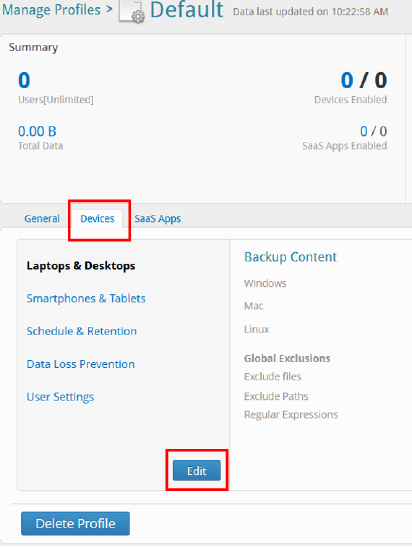
-
Check if there is any such folder path that is being backed up from under two separate folder configurations.
For example, the following is an INCORRECT configuration:

As shown in the above screenshot, the My Documents folder is being scanned from under the My Documents section as well as %userprofile% section.
Thus, the Audio files are backed up twice-- once from the My Documents configuration and second, from the %userprofile% configuration. This leads to excess use of storage space unnecessarily. -
As per the above example, uncheck the My Documents folder configuration.
If you wish to backup specific file types from under My Documents and some other files from under %userprofile% , then you may keep both the folders selected, but then ensure that the file types are defined such that they are not being backed up twice. -
Regarding backing up Audio, Video, and Image file types; such file types have a very little scope of compression. Thus, the amount of storage used by these file types could lead to excessive usage of the storage space in the cloud.
Check with your end-users, if they absolutely need such file types to be backed up. If they do not need such file types, then do not include them in the Include File Types section of that folder configuration.
If there are only some users that need such files to be backed up -> then you can create a copy of the existing profile from the Profiles page as shown below:
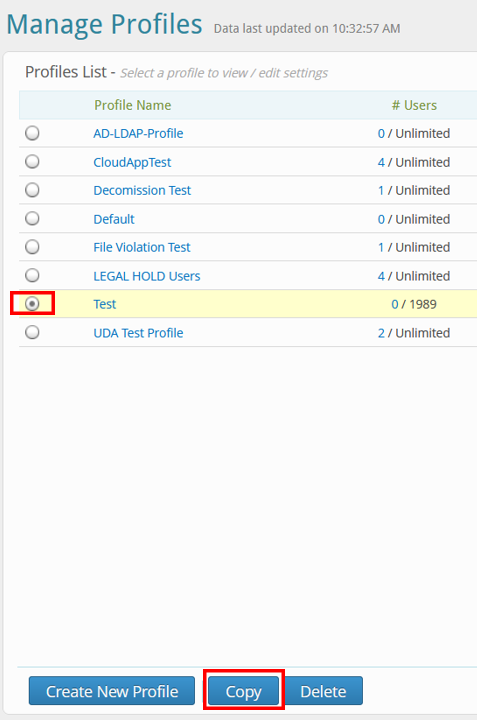
-
Once the profile is copied, all the configurations under the copied profile will be identical to the original profile.
-
Now under this copied profile, you may leave the Audio, Video, and Image file backup enabled.
-
Go to the Users page and select the checkboxes of the users that need such a backup.
Click on the ellipsis above -> select change profile -> move them into the copied profile.
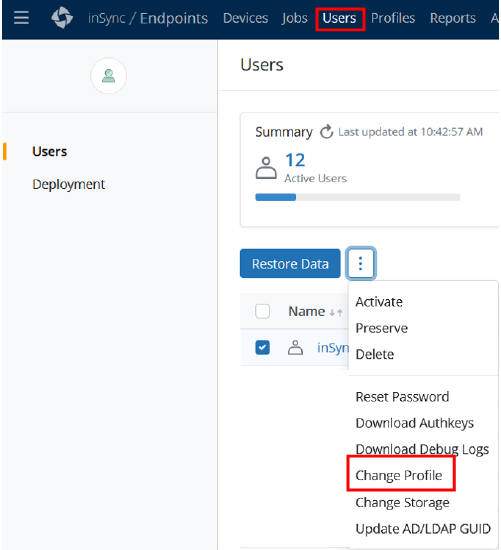
-
Back in the original profile. Remove the Audio, Video, and Image file types from the backup configuration for the users who do not need them.
Optimize the backup frequency
Under the inSync Profiles -> Device -> Schedule & retention -> Edit, you will find the settings for adjusting the backup frequency as shown below:
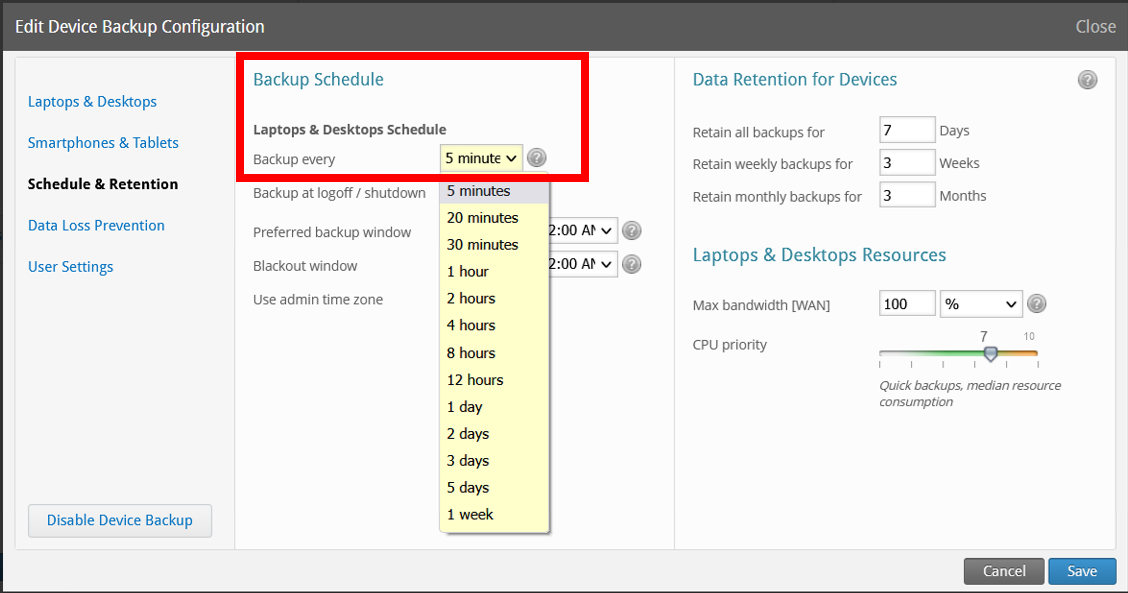
Consider the following example, where the backup frequency is every 30 minutes:
- If a user is working on a Video Project, that has huge data files created on the machine. The backup runs and backs those files up every 30 minutes.
- Throughout the day, the user edits that project quite often, so each backup will contain new sets of files from the machine.
- By the end of the day, the user finishes the project and saves it as the final one. In this case, the user may not really need all the old files, which he might have already deleted from the machine.
- However, inSync ended up backing them up anyway every 30 minutes, leading to unnecessary data in the backup; that the user won’t even need.
Thus, understand the requirements of the end-users and based on that; set the backup frequency.
Optimize the retention policies
InSync Profile offers to retain “daily”, “weekly” and “monthly” snapshots for your end-users.
This setting is available under Under the Profiles -> Devices -> Schedule & Retention tab:
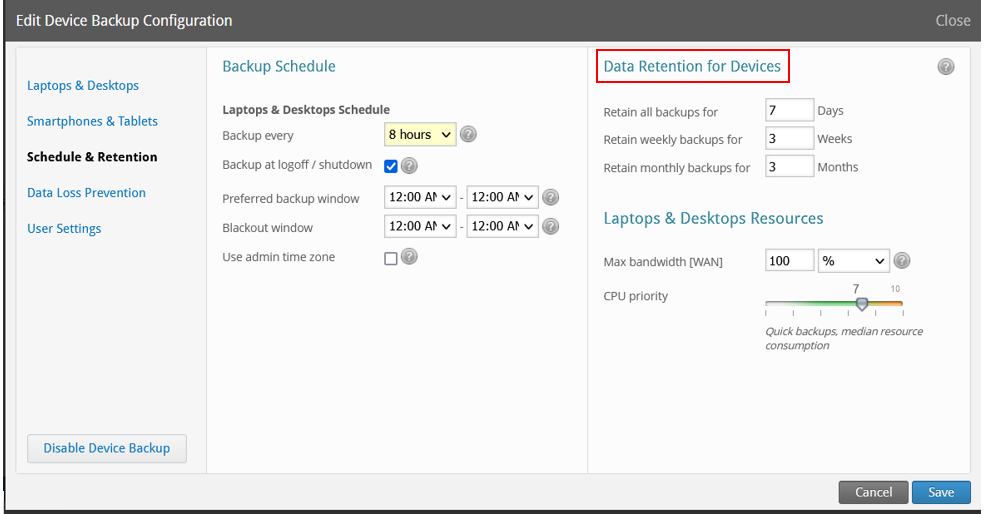
How many daily, weekly or monthly snapshots you need; will depend on how often do your end-users lose or may lose the data from their devices and how often do you get requests for performing the restores.
This decision will also depend on your company policies.
Keep the retention policy as low as possible, to get rid of the unwanted data over the period of time.
Allow users to add folders to the backup
Go to Profile -> Devices -> User Settings -> Add backup folders (laptops & desktops).
- This setting allows or disables the users from adding backup folders in the inSync client.

- Ideally, it is recommended to keep this disabled, so that you can manage the backup folders centrally from the Console.
-
By enabling this feature, it will certainly help users to add their own custom folders for backup. But then, this may also lead to scenarios where the users may add certain folders to the backup more than once. For example:
-
Admin has configured to back up the My Documents folder from the inSync profile.
-
The end-user creates a folder within My Documents.
-
Then the end-user adds that folder for backup using his inSync client.
-
Thus, the user-created folder is now getting backed up twice, which will lead to unnecessary usage of storage space in the cloud.
As a best practice, keep this option unchecked, so that Admins can manage the backup policies centrally for all the users.
SaaS App Backup Policies
If you are backing up SaaS Apps like M365 and Google Workspace, then in the inSync Profile -> click on the SaaS Apps tab
-
For Google Drive, check if you wish to backup, shared data owned by other users, this option will backup all the data that is shared with the Google Drive User; which will lead to large data usage in inSync Cloud. We recommend you enable this option only if absolutely necessary for any specific set of users.
-
Under Exchange Online, you have an option to backup Recoverable Items folder. Enable this if absolutely necessary, for a specific set of users; as this will also add up the storage usage, which may not be useful to the user or the organization.
SaaS App Retention Policies
Similar to Step # 3, adjust the Daily, Weekly, and Monthly retention policies for file-based cloud app sources like Google Drive and OneDrive; to an optimum level.
Adjust the email retention for Gmail and Exchange Online sources, to an optimum level.
Keep the retention as little as possible.

